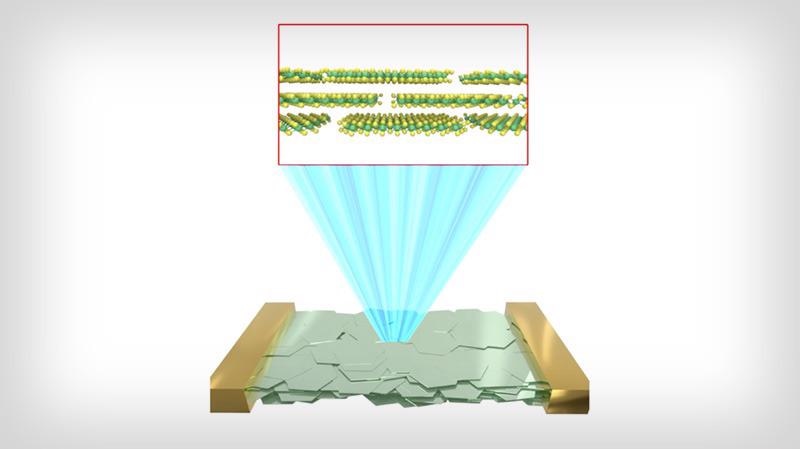Scientists from the University of California (UCLA) have created an exclusive design of ultrathin films for extremely flexible yet mechanically strong bioelectronic membranes that could open doors for diagnostic on-skin sensors that can be positioned precisely over the body’s contours and adapt to its movements.
 The layered patchwork design of van der Waals thin film enables the membrane to stretch and flex over irregular geometries. Image Credit: Yan et al./UCLA.
The layered patchwork design of van der Waals thin film enables the membrane to stretch and flex over irregular geometries. Image Credit: Yan et al./UCLA.
An article illustrating the research co-led by Xiangfeng Duan, professor of chemistry and biochemistry; and Yu Huang, professor and chair of the Materials Science and Engineering Department at the UCLA Samueli School of Engineering has recently been published in the journal Science.
Secured together by van der Waals forces, intermolecular interactions that can only occur at very close distances between atoms or molecules, the membrane is stretchy and versatile to dynamically altering biological substrates while being breathable and permeable to air and water.
The progress of the tough electronic material could pave the way to the creation of noninvasive electronics for medicine, biology, health care, horticulture and agriculture. The scientists labeled the material van der Waals thin film, or VDWTF, which could act as a foundational platform for living organisms to embrace electronic capabilities.
Conceptually, the membrane is like a much-thinner version of kitchen cling film, with excellent semiconducting electronic functionality and unusual stretchability that naturally adapts to soft biological tissues with highly conformal interfaces.
Xiangfeng Duan, Professor of Chemistry and Biochemistry, Samueli School of Engineering, UCLA
“It could open up a diverse range of powerful sensing and signaling applications. For example, wearable health-monitoring devices built with this material can accurately track electrophysiological signals at the organism level or down to the level of individual cells,” Duan added.
The team developed a number of demonstrations using the thin films, including a transistor that was positioned on top of a leaf of a succulent plant, whose copious electrolytes were used to develop the electronic circuit. They also built a similar transistor for human skin that used electrolytes-present skin cells to accomplish the circuit.
Furthermore, the researchers designed an electrocardiogram that employs small circles of the film positioned on a person’s right and left forearm and could sense their blinking while in meditation.
Our proof-of-concept demonstrations using the van der Waals thin film really just hint at the myriad possibilities for this new material. The membrane could serve as the connection for human-machine interfaces, enhanced robotics and artificial intelligence-enabled technologies that connect directly.
Yu Huang, Professor and Chair of Materials Science and Engineering Department, Samueli School of Engineering, UCLA
“This could open a pathway to synthetic electronic-cellular hybrids—cyborg-like living organisms with electronic enhancements,” Huang added.
The ultrathin, around 10-nanometer-think electronic membranes are composed of numerous layers of atomically thin sheets of the inorganic compound molybdenum disulfide. Each sheet is merely two to three nanometers in thickness — over 10,000 times thinner than the diameter of a strand of human hair.
The key to preserving the structural integrity of the membrane while maintaining its thinness lies in its exclusive layered patchwork structure. The layers are not one continuous sheet but rather an assemblage of smaller sections.
Instead of being secured in place by unyielding covalent bonds, the layers are lightly connected by nonbonding van der Waals forces. This enables the sheets to freely slide and rotate over one another, forming excellent pliability while maintaining their electronic functionality complete.
The design also allows the membranes to stretch and flex over asymmetrical geometries. The thin films can stick to soft biological tissues with a comfortable fit over their micrometer-scale topologies, effortlessly merging with, and actively adapting to, dynamically varying biological substrates, such as skin, without tearing or hindering the membranes’ functionality.
The layered patchwork forms a percolating system of nanochannels, large enough for air and water molecules to pass through, giving the material its breathability and permeability.
With its uncommon combination of malleability and high electronic performance, the van der Waals film resolves numerous challenges exhibited by other candidates for bioelectronic thin films, such as organic thin films or inorganic membranes.
Those substitutes have been restricted by their thickness, incompatibility to unite with asymmetrical geometries of biological surface, lack of stretchability, or by their weak performance in wet biological surroundings.
The study’s other authors, all from UCLA, are Zhuocheng Yan, Zhaoyang Lin, Peiqi Wang, Bocheng Cao, Huaying Ren, Frank Song, and Chengzhang Wang from Duan’s research group; and Dong Xu, Laiyuan Wang and Jingxuan Zhou from Huang’s research group; as well as bioengineering graduate student Xun Zhao and his advisor Jun Chen, an assistant professor of bioengineering at UCLA Samueli.
Duan and Huang are both members of the California NanoSystems Institute (CNSI) at UCLA.
The study was received support from the UCLA Physical Sciences Entrepreneurship and Innovation Fund, with extra support from the CNSI Noble Family Innovation Fund. The authors acknowledge technical support from Electron Imaging Center at UCLA and the Nanoelectronics Research Facility at UCLA.
The UCLA Technology Development Group has also applied for a patent for the technology.
Journal Reference:
Yan, Z., et al. (2022) Highly stretchable van der Waals thin films for adaptable and breathable electronic membranes. Science. doi.org/10.1126/science.abl8941.